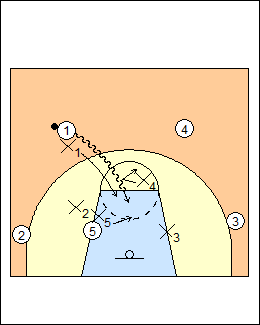Dave Smart weak-hand
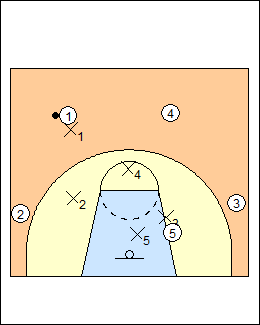 | 1 Dave Smart Basketball Immersion See Defence - Dave Smart rotations, ballscreens, posts. Also see Hoop Vision article and video (and Forcing-left pack). It's not a forcing-left defence, that makes no sense. To force anybody anywhere on 80% of the floor is insane. There's shading (getting somebody to make a play with a certain hand), and there's forcing, if you're forcing most of the time you're allowing people to get into the paint, even though it may be in the direction you want. You can't let the ball get to the paint easily. Good players are going to be able to beat you going left or right, and in a lot of ways it's easier going left because they're crossing their body with the first step and sealing you better. If you force a rightie to their left anywhere on 80% of the floor, they're going to get there more than if you square them up and defend the ball and take it personally. You want to find matchups where players have the best chance of covering guys 1 on 1 so you have no help situations. Help situations cause a whole lot of bad things - long closeouts (which cause straight-line drives) and short closeouts (which cause movement of the defence, which causes offensive rebounding lanes, which is going to kill you). Any kind of penetration is going to hurt you. The first step is matching up, being square, and keeping the ball out of the paint. On any short closeout anywhere on 80% of the floor, we are not forcing weak hand, we are squaring the ball and shading maybe a little left, mostly so you can get a (right) hand in the pocket and a (left) hand over the ball, mirroring the ball. Dave Waknuk (Lock-left defence) - Canada Basketball terminology - force left - on his right hip, making him go left, very aggressive - influence left - still have an angle on him, split him (with your right i.e. back foot) - shade left - square him up but split him, stay in front a bit more. Shade left if you're having trouble with influence left. |
 | 2 In 20% of the floor, you can force to the baseline, get it to 15 feet (short corner) as opposed to giving a straight line to the basket. It causes defensive movement, but the movement is natural to protect the basket, now the rightie is going to his left and has to make a play from the baseline with nowhere to go, the defence is using the baseline as a defender, length, and the backboard, things that don't help you on the other 80% of the floor. Wanting the ball in the left hand is not about people scoring, it's about passing, baskets are made when passes are on time and on target. Only Phil Scrubb and Steve Nash pass it better left than right. It's the same thing for bigs. See Defending - Schepp closeouts, Spurs shift and close. |
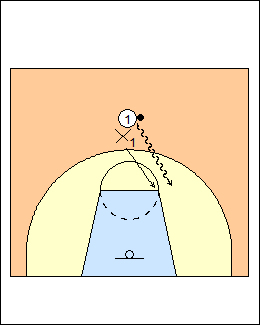 | Play 1 on 1 every day, the point system is key, and it's the same point system when they are doing a 5 on 5 defensive drill. 1 gets one point if he scores inside 15 feet going to his weak hand (a layup or pull-up). If he scores going to his strong hand he gets 3 points at the rim and 2 points otherwise inside 15 feet. If he makes a pull-up right or left outside the foul line he gets 0 points but keeps the ball (X1 has to make a stop to get the ball). Any 3 is worth one point. If 1 attacks with his left hand, X1 should not let him get back to his right hand, try to push him away to make a shot or, more importantly, be a passer going to his left. If 1 attacks rights, create space (gap off), cut him off, force him back left, turning 3 points into 1 point. If you can force people to shoot pull-up jump shots from 17 feet, you're winning; it makes zero sense to shoot pull-up jump shots unless it's late in the shot clock. You get more points per possession if you shoot 3s or layups. For 22 years they have said no pull-ups unless it's 4 seconds or less on the shot clock, it's got to be a layup or 3. Taffe Charles doesn't allow his players to shuffle, just turn, cross and chase, daring the ballhandler to get to a secondary move. See 1 on 1 - Dave Smart first step. |
 | 4 Short Closeout 4 attacks, X3 bluffs a little bit, 4 passes to 3, that's always a short closeout, here it's in the 20% of the floor (everywhere else you're square). If 3 makes a skip pass to 1, X1 would be there on the catch, that's a short closeout. |
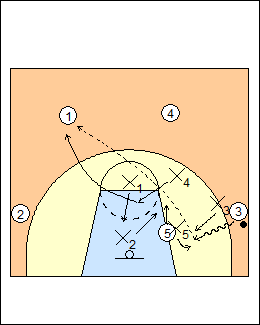 | 5 Long Closeout A long closeout is very different from a short closeout. An attack causes a long closeout. Here there is an attack by 3, be beats X3, we have to help, rotate, drop, now it's a long closeout on a skip pass to 1. However, it's not an automatic long closeout, if they're dumb enough to put someone who can't shoot out there, then it's a short closeout - close out short daring him to shoot it. If he's a shooter you have to close out long to take away shot, change the closeout angle, get on his shooting hand, make sure he does not go two directions, i.e. he cannot go right. Every defender knows exactly where he is going to go. See Defence - Dave Smart rotations. |
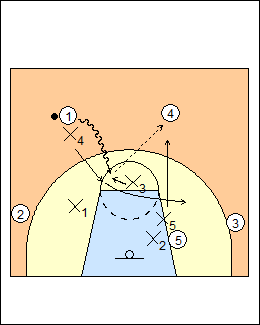 | 6 X3 takes the nail away. Everybody knows we're going to get 1 off the line because he's a shooter, and everybody knows where he is going to go. X4 takes the 3-point shot away, angles it so that 1 does not go right, X1 is open to discourage in the bluff. When 1 puts it on the floor, we're ready to help, it's a blow-by and three-man rotation, X3 helps and stays and X4 is gone, to cover 3. On a long closeout we take the shot away, know where the help is going to come from, know the help's probably going to come, trust that we understand what we're doing more than the offence understands the re-spacing situation. It is extremely important that 1 does not go strong hand on that catch, ever. Once you get in trouble, make sure you dictate where the ball goes. How we cover long and short closeouts is very important. |
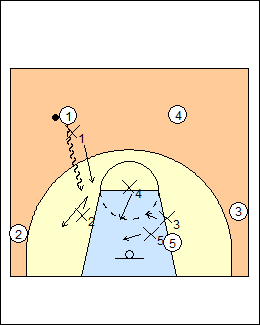 | 7 Bluffing and Helping Five guys have to cover the ball all the time. Every time the ball is put on the floor you're bluffing or helping. On short closeouts, 95% of the time it should be a bluff, on long closeouts on shooters, 80% of the time it's going to be a help. X1 is square, he's got help everywhere, cover the basketball, don't give, shade it to 1's weak hand, but if 1 makes his first move right it's fine because everyone is bluffing, everybody has to move, every time. X2 is bluffing and getting back, knows he doesn't have to help because X1 is going to cover it or turn 1 (to his left hand). X2 is helping X1 to cut it off with his bluff. X4 is bluffing and moving because X1 may be turning 1 to a help. |
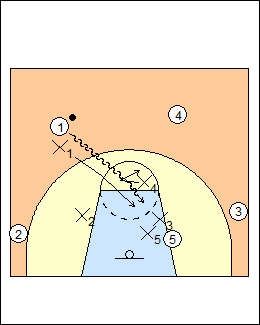 | 8 If X1 puts it on the floor left, X4 on the nail has to bluff. Bluff means X1 does not need help, he cuts off 1 (not fully cut off and let him go right), pushes him away from the basket going left. When is it a help? When would X4 have to call help? The guy who helps calls help if he needs help, when he's too far away from his guy. X1 is guarding the ball, he doesn't call help. |
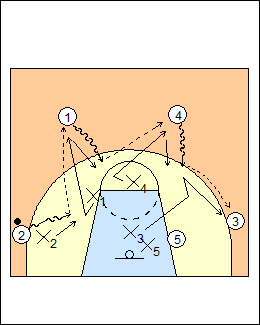 | 9 If 2 dribbles once to his left, X1 bluffs and gets back, closes out on a pass to 1, X4 bluffs and back when 1 takes one dribble, X3 bluffs and back on a dribble by 4. If 3 drives baseline, X5 would want to bluff and help cut it off, but if 3 drops his head and goes, X5 would have to help, and calls help when he needs help. When 2 has the ball in the corner, X3 should never be under the basket, he shifts ballside or weakside based on whether 2 or 3 can score. X4's guideline is still cut the floor in half. |
 | 10 On-ball Calls The only time you call "ball" is in transition defence, but X1 needs to communicate, the calls are pretty simple. If he doesn't need any help at all he yells "dead", he's on an island (1 still has his dribble), X2 and X4 can deny, and X3 step towards 3. Move to a position where 1 can't pass to your guy. |
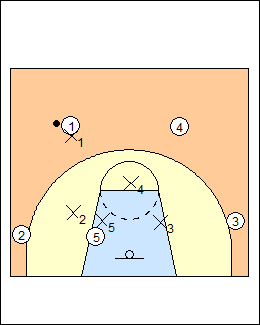 | 11 If the matchup is pretty much even, X1 yells "weak (or "left" or "right"), a normal situation, X4 is on the nail, X2 is open. |
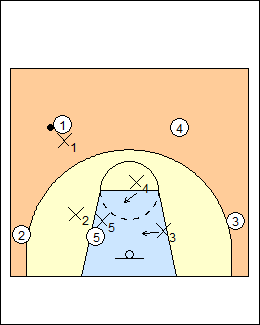 | 12 X1 calls "early" if 1 is the best offensive player, X4 gets in the paint and opens up (facing the ball), X2 opens up, but it's still short closeouts, still have to play their guys. X3 takes a step to the middle. 1 sees passing lanes. Everybody off the ball is listening to X1's call but should be able to figure it out on their own based on the matchups. |
This page was made with Basketball playbook from Jes-Soft
